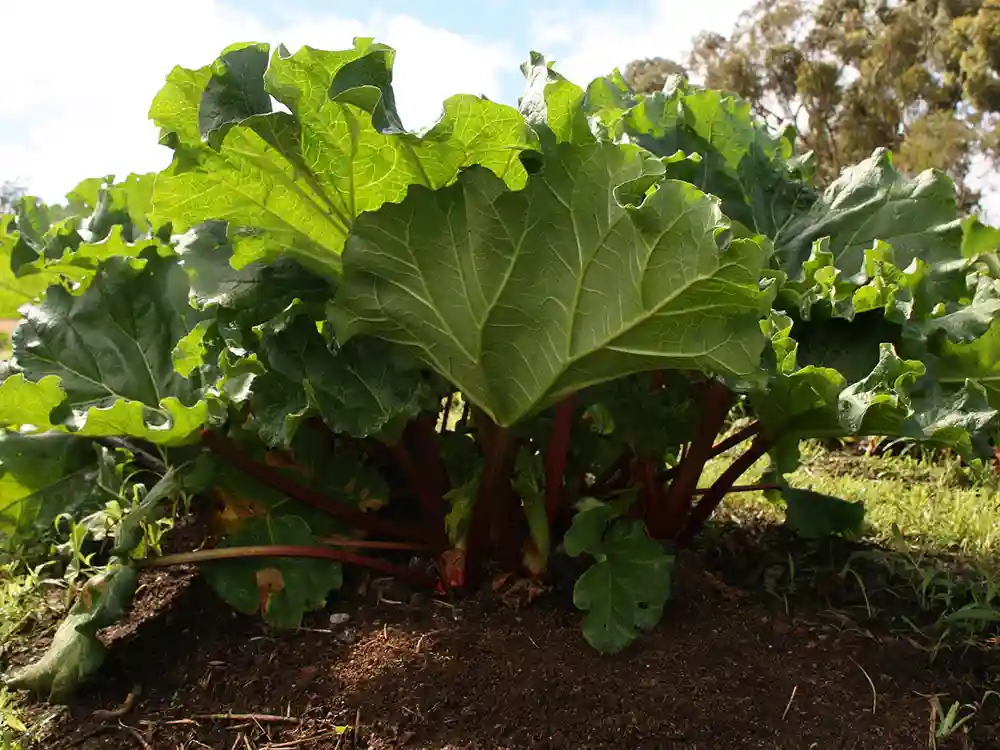Today, we’re going to dive into the wonderful world of growing rhubarb from seed. Starting it from seed can be a rewarding adventure. Whether you’re growing rhubarb in containers or planting it straight into the ground, we’ve got all the dirt you need to know. So, let’s get down to the root of the matter!
Rhubarb Basic Info
| Common Name | Rhubarb |
| Scientific Name | Rheum rhabarbarum |
| Days to Harvest | Harvest the following spring when grown from seed |
| Light | Full sun to partial shade |
| Height | 2 to 3 feet |
| Spacing | 4 to 6 feet between plants |
| Soil | Rich, well-draining soil |
| Water | Regular watering, moist soil |
| Fertilizer | Balanced, slow-release fertilizer |
| Pests | Herbivores, aphids, slugs |
| Diseases | Crown rot, leaf spot |
Why Grow Rhubarb from Seed?
First and foremost, growing rhubarb from seed is incredibly rewarding. If you’ve ever experienced the thrill of nurturing a tiny seed into a thriving plant, you’ll understand the sense of satisfaction it brings. It’s like seeing a tiny miracle unfold right before your eyes!
On a more practical level, starting rhubarb from seed can give you a wider variety of rhubarb to grow. Most garden centers only offer a few common varieties of rhubarb plants.
Growing rhubarb from seed is also a cost-effective way to start a rhubarb patch. For the price of a single rhubarb crown, you can buy a pack of seeds that could potentially provide you with many more plants.
Lastly, growing rhubarb from seed allows for a stronger plant. When compared to transplanted crowns, rhubarb grown from seed generally has a stronger root system. This means it can weather harsh conditions better and live a longer life.
How long do rhubarb seeds last?
When stored in cool, dry conditions, rhubarb seeds can stay viable for about three years. However, like all seeds, their germination rate decreases over time, so fresher is typically better.
Best Varieties
When it comes to rhubarb, choosing the right variety is crucial for a successful harvest. Some popular and reliable varieties of rhubarb that are known for their flavor and productivity include:
- Victoria: This is a classic variety with green stems that turn red as they mature. Victoria rhubarb is known for its sweet and tangy flavor, making it perfect for pies and jams.
- Crimson Cherry: As the name suggests, this variety has bright red stems that are sweet and tender. It’s a great choice for both culinary and ornamental purposes.
- Valentine: This variety produces deep red stems and is known for its early maturity, making it a great option for gardeners who want to start harvesting rhubarb early in the season.
Choosing the Right Variety
When choosing a rhubarb variety, it’s important to consider factors such as your climate, soil conditions, and intended use. Some varieties are better suited for colder climates, while others thrive in warmer regions.
The color of the stems may vary depending on the variety, so choose one that best fits your aesthetic preferences and culinary needs.
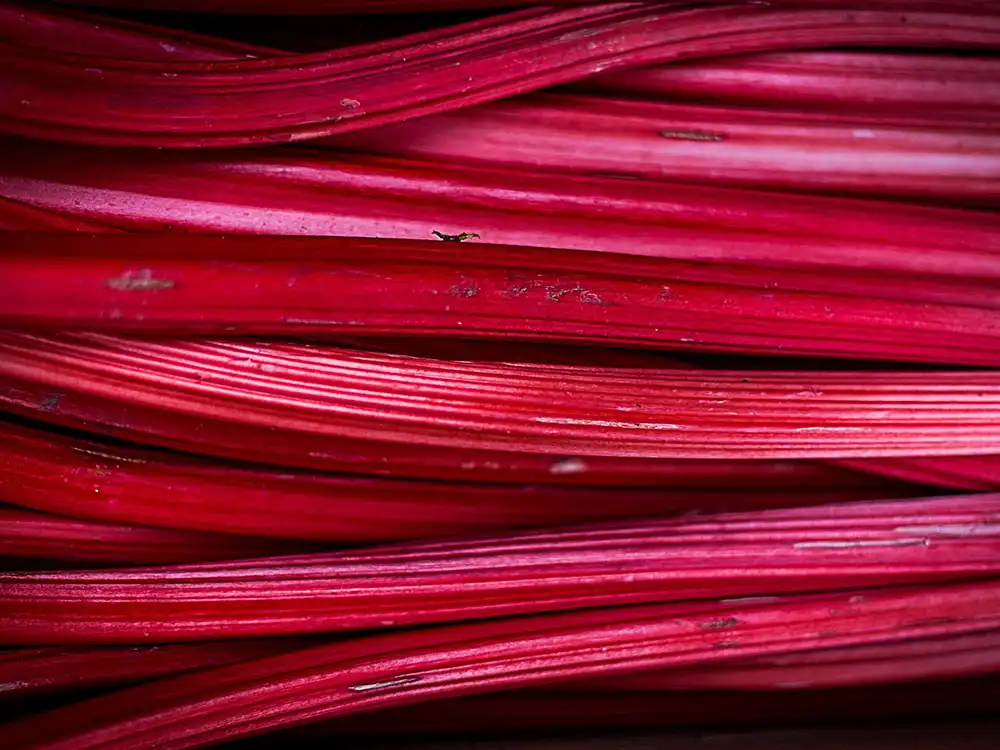
Preparing for Planting
Before we get our hands dirty, let’s chat about the right way to get those rhubarb seeds ready for planting. If you’ve ever tried growing rhubarb from seed before and struggled, don’t fret. The process may take a bit of prep work, but trust me, it’s worth the effort.
Best Time of Year to Plant Rhubarb Seeds
First things first: timing. If you’re wondering when to start growing rhubarb, the best time to plant rhubarb seeds is late winter to early spring. If you live in a warmer climate, you might be able to get away with planting a bit earlier. The goal here is to start your seeds indoors while it’s still a bit chilly outside, so that by the time all risk of frost has passed, your seedlings will be robust enough to transplant into your home garden.
Preparing Rhubarb Seeds for Germination
Rhubarb seeds have a higher chance of germinating if they think they’ve gone through a cold winter. This process is known as stratification. To trick your seeds into thinking they’ve had their winter chill, keep them in the refrigerator for a few weeks before you plan to plant them.
The Ideal Seed Starting Mix for Rhubarb
A good seed starting mix can be a game-changer when it comes to growing rhubarb from seed. It’s essential for giving your little seeds the best possible start in life.
The best seed starting soil for rhubarb should be light, well-draining, and fertile. Consider using a blend of equal parts peat moss or coconut coir, vermiculite or perlite, and compost.
- CONTAINS: This organic Seed Stating soil mix is a rich blend of sphagnum peat moss & perlite with yucca extract and lime to ensure correct pH.
Planting Process
Ready to sow your rhubarb seeds? I know, it’s exciting! Here’s the step-by-step rundown to guide you on how to sow your rhubarb seeds just right.
How to Start Rhubarb Seeds Indoors
- Prep your containers: Make sure your seed trays or pots are clean to prevent disease. Fill them with your perfect seed starting mix.
- Plant the seeds: Sow rhubarb seeds thinly over the surface of the soil. It’s better not to crowd them; this way, you’ll prevent fungal diseases and competition.
- Cover the seeds: Sprinkle a light covering of soil over the seeds, only about a quarter of an inch.
- Water gently: Use a fine mister to water the seeds. Aim for a moist but not drenched soil surface.
How to Care for Rhubarb Seedlings
Once your seeds have sprouted into seedlings, here’s how to keep them happy:
- Light: Make sure your seedlings get plenty of light. A sunny windowsill or a set of grow lights will do the trick.
- Water: Keep the soil consistently moist. Again, a mister is your friend here.
- Temperature: Maintain a temperature around 70-75°F for optimal growth.
- Thinning: Once the seedlings have grown a few true leaves, thin them out so each plant has its space.
Starting rhubarb from seed is a bit like starting a new journey. There’s a lot of anticipation and a bit of effort, but with these steps in hand, you’re all set to embark on this exciting adventure.
When to Transplant Rhubarb Seedlings
Transplanting your rhubarb seedlings is a crucial step in growing rhubarb from seed. The best time to transplant rhubarb seedlings outdoors is after the last frost in spring. But remember, don’t rush them out the door. Start hardening them off about a week before the big move.
Begin by placing them outside in a sheltered spot for a couple of hours a day, gradually increasing the time outdoors over a week or so.
Hardening off involves gradually exposing the seedlings to outdoor conditions to help them adapt to the change.
How to Care for Rhubarb Plants
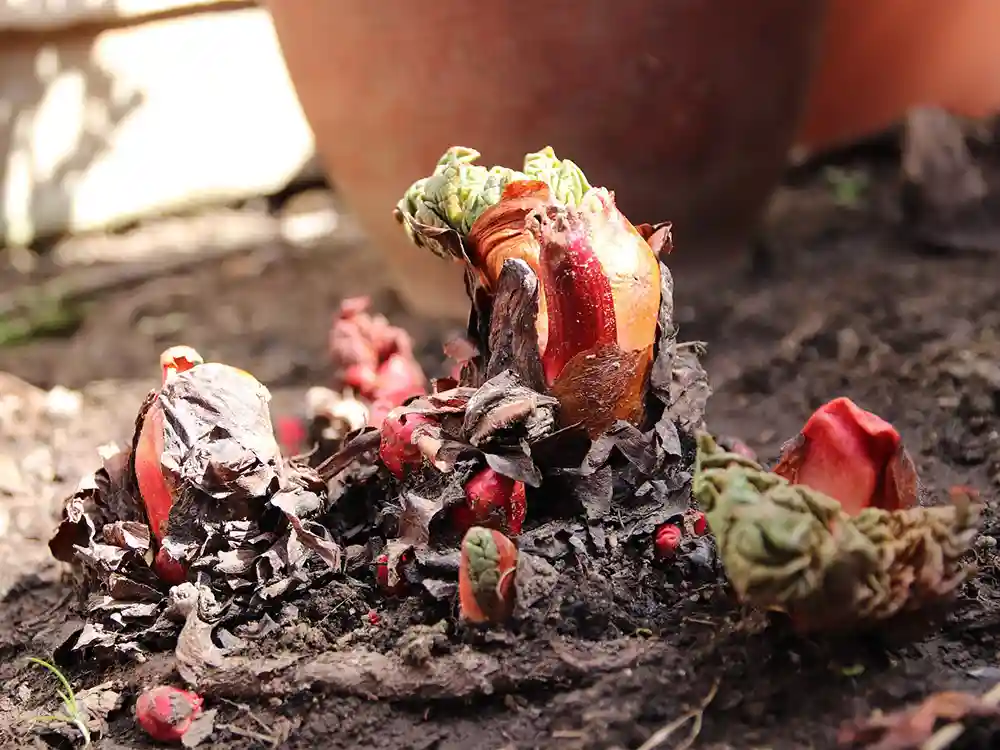
Alright, now that your rhubarb seedlings are snug in their garden beds, it’s time to shift gears. Let’s discuss the best practices to ensure your plants thrive and grow to their full potential.
Once you’ve transplanted your rhubarb seedlings, it’s all about maintenance:
- Watering: Rhubarb likes consistently moist soil, so water regularly, especially in dry periods. Just make sure the area has good drainage—soggy soil is a big no-no!
- Feeding: Give your rhubarb a boost with a balanced fertilizer at the start of spring to help promote vigorous growth.
- Mulching: Mulch around the base of the plants to help conserve moisture and suppress weeds. Well-rotted manure or compost works great as a mulch and provides an additional nutrient boost.
- Weed Control: Keep the area around your rhubarb plants weed-free. Weeds compete with rhubarb for nutrients, water, and space.
Rhubarb Companion Plants
And don’t forget about companion planting! Growing rhubarb in the home garden can be even more successful if you pair it with the right friends.
Onions and garlic are known to be great companions for rhubarb because they help deter pests.
But keep rhubarb away from other root crops like carrots or potatoes. They’ll compete for the same soil nutrients, and that’s a battle no one wants.
Harvesting Rhubarb
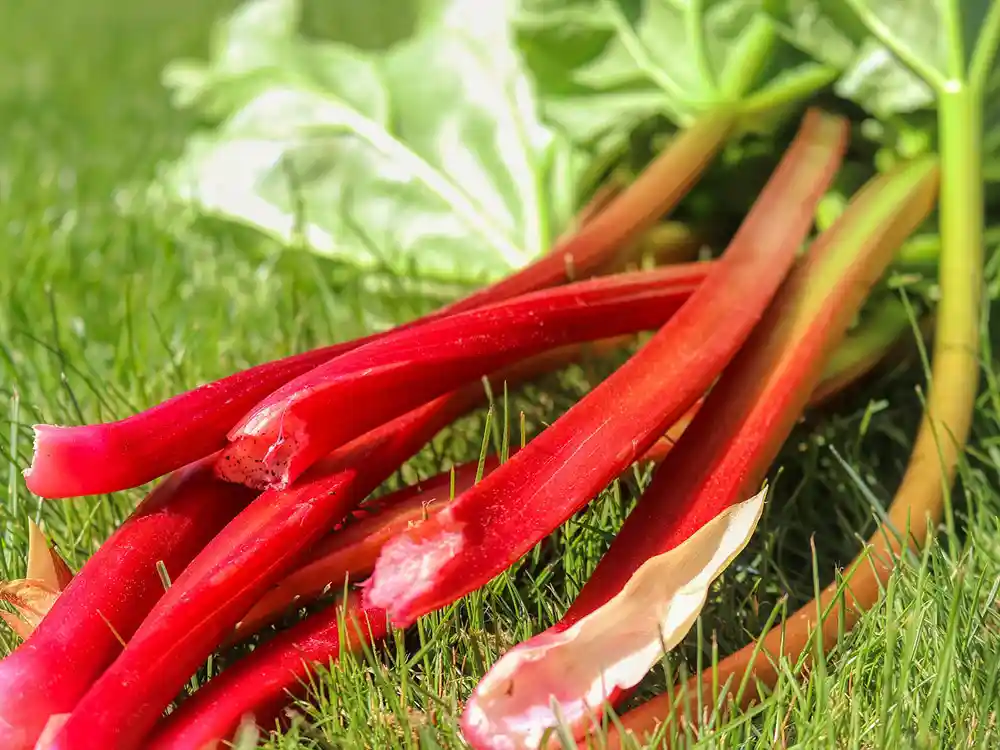
So, you’ve done all the hard work, and now you’re growing rhubarb in the home garden, maybe even in containers. Let’s turn our attention to one of the most satisfying parts of the gardening journey: harvesting. Yes, it’s time to enjoy the fruits, or in this case, stalks, of your labor!
When and How to Harvest Rhubarb
Patience is key when it comes to harvesting rhubarb. If you’ve started your plants from seed, wait until the second spring after planting before you begin harvesting. I know, it’s a long wait, but it’s crucial to let your plant build up its energy reserves in that first year.
Rhubarb is usually harvested in spring and early summer, while the stalks are still tender and full of flavor. Here’s how to do it:
- Choose your stalk: Look for stalks that are about 10 to 15 inches long. A mature stalk is usually firm and crisp, with a vibrant red or pink color.
- Pull, don’t cut: To harvest, grasp the stalk at the base and pull upward with a gentle twist. This method ensures you don’t damage the crown.
- Leave some stalks: Don’t be greedy; always leave at least two or three stalks per plant. This allows the plant to recover and continue growing.
- Remove the leaves: The leaves of rhubarb are toxic, so always remove and dispose of them safely.
WARNING! Never eat the leaves of rhubarb, they are toxic!
Signs Your Rhubarb is Ready for Harvest
Besides the length of the stalks, color is a good indicator that your rhubarb is ready for harvest. The stalks should be a deep red or pink color. However, don’t worry if they’re still a little green—color can vary based on the variety of rhubarb and isn’t always a sign of ripeness.
But the key sign your rhubarb is ready for harvest? Taste. If you’re unsure, taste a small piece of the stalk (remember to remove the leaf). If it’s sweet and tangy, you’re good to go!
Tips on Maximizing Yield or Growth
Here are some additional tips on how to maximize the yield and growth of your rhubarb plant:
- Mulching: Mulching around the base of your rhubarb plant with organic matter, such as straw or wood chips, can help retain moisture in the soil, suppress weeds, and provide nutrients as the mulch breaks down.
- Dividing: Rhubarb plants can become overcrowded over time, which can result in reduced yield and vigor. To prevent this, you can divide your rhubarb plant every 5-6 years. Dig up the plant in the fall or early spring, and separate the crowns with a sharp knife or shovel. Replant the divided crowns in well-prepared soil with adequate spacing between each plant.
- Winter Protection: In colder climates, it’s important to protect your rhubarb plant from harsh winter weather. After the first frost, cut back the leaves and stems of the plant to about 2 inches above the ground and cover the crown with a thick layer of mulch or straw. This will help insulate the plant and protect it from freezing temperatures.
- Regular Maintenance: Regularly remove weeds, dead leaves, and stems from around your rhubarb plant to promote good air circulation and prevent the spread of diseases. Keep an eye out for any signs of pests or diseases and address them promptly to prevent them from causing further damage to your plant. Additionally, ensure that your rhubarb plant receives adequate water, sunlight, and nutrients to support healthy growth.
- Harvesting Practices: When harvesting rhubarb, always use a pulling or twisting motion to remove the stalks. Do not use a knife or scissors to cut the stems. Only harvest a third to a half of the stems at a time, leaving the remaining stems to continue to grow and nourish the plant. Avoid harvesting rhubarb stems that are too thin or weak, as they may not be as flavorful.
- Companion Planting: Planting companion plants, such as garlic, onions, and nasturtiums, around your rhubarb plant can help repel pests and attract beneficial insects that can help control pests.
- Pruning: In the late fall or early spring, remove any dead or damaged leaves, stems, and flowers from your rhubarb plant to promote new growth and prevent the spread of diseases. Pruning also helps improve the overall appearance of the plant and promotes better air circulation.
Culinary Uses for Rhubarb
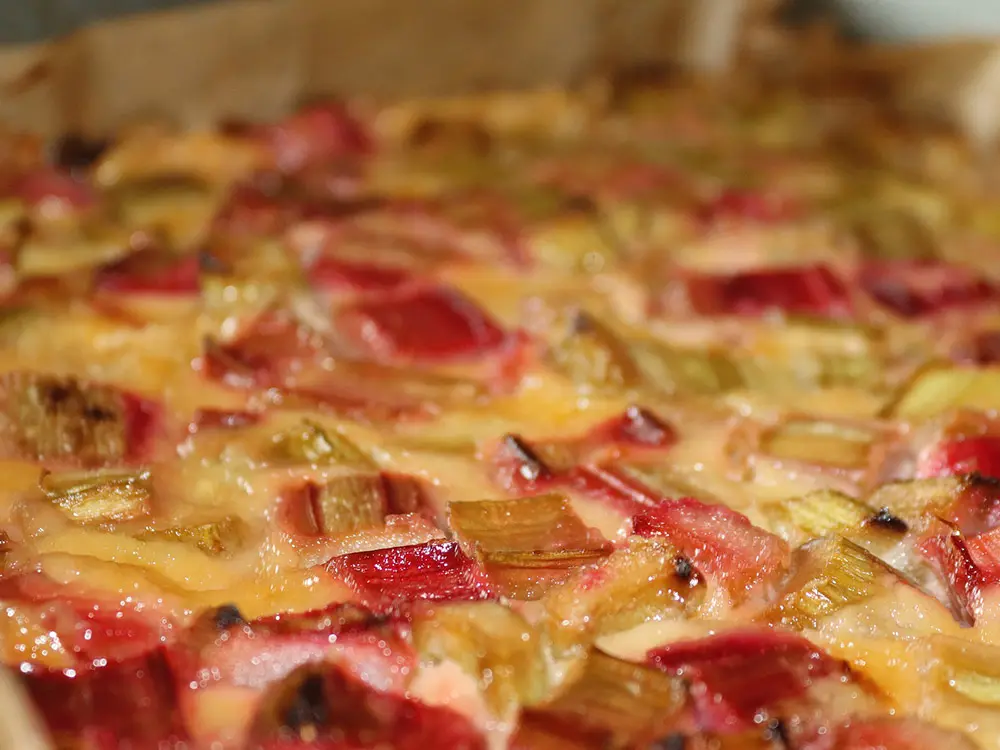
Ah, the culinary delights of rhubarb! It’s one of those unique ingredients that offers a refreshing tartness, making it a shining star in both sweet and savory dishes. Let’s take a moment to appreciate all the delicious ways you can use your home-grown rhubarb:
Rhubarb Pies and Tarts: This is probably what rhubarb is most famous for. The tartness of the rhubarb pairs beautifully with sweet, flaky pastry. Throw in some strawberries, and you’ve got yourself a classic springtime dessert.
Rhubarb Jams and Compotes: Rhubarb’s tart flavor also makes it excellent for making jam or compote. A dollop of rhubarb jam on your morning toast or a spoonful of rhubarb compote over your vanilla ice cream? Delicious!
Rhubarb Sauce: Pureed rhubarb sauce can be a delightful addition to both sweet and savory dishes. It can accompany pancakes, be used as a glaze for meats, or be drizzled over your favorite dessert for an extra punch of flavor.
Rhubarb Cocktails: If you’re feeling a bit adventurous, why not try a rhubarb cocktail? Rhubarb simple syrup or rhubarb-infused spirits can add a unique, refreshing twist to your favorite drinks.
Rhubarb Pickles: Yes, you read that right! Pickled rhubarb can be an exciting addition to your salads, cheese boards, or even your sandwiches.
So, there you have it—a myriad of ways to enjoy the fruits (or should we say, stalks) of your labor.
Conclusion
And that’s the long and short of growing rhubarb from seed. Remember, gardening is a journey, not a destination. So, enjoy the process and don’t forget to have fun along the way. Here’s to your delicious home-grown rhubarb!
FAQ: Growing Rhubarb from Seed
How long does it take to grow rhubarb from seed?
From seed to harvest, rhubarb typically takes about two years. This allows the plant to establish a robust root system in the first year, ready for some harvesting in the second year.
Is rhubarb easy to grow from seed?
Growing rhubarb from seed requires some patience, but it’s not overly complicated. With the right preparation, care, and a bit of love, most gardeners find success growing this perennial plant from seed.
Does rhubarb like sun or shade?
Rhubarb thrives in full sun but can tolerate partial shade. However, for the most productive plants, a sunny spot with well-draining soil is your best bet.
What month is best to pick rhubarb?
The best time to harvest rhubarb is during spring and early summer, when the stalks are still young and tender. After a big harvest in early summer, let your plants recover for the rest of the year.
How do you winterize rhubarb?
To winterize rhubarb, remove any dead leaves or stalks in late fall. Then, add a thick layer of organic mulch around the base of the plant to protect the roots from freezing temperatures.

